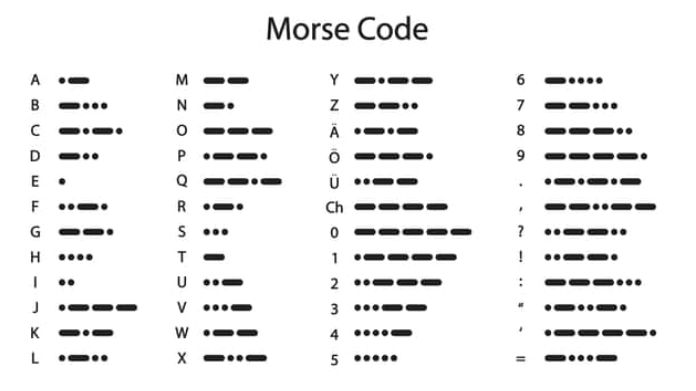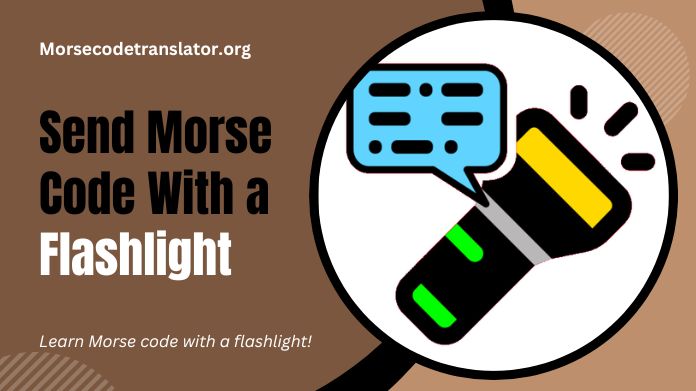This article will help you understand how to send Morse code with a flashlight. In the vast landscape of modern communication, the art of Morse code remains a timeless skill, persisting even in an era dominated by advanced technologies.
Today’s intriguing and practical application of Morse code involves utilizing a commonplace tool – a flashlight. This Morse Code Translator guide explores the captivating world of how to send Morse code with a flashlight, seamlessly blending historical significance with contemporary utility.
As we navigate this illuminating journey, we’ll unravel the simplicity and effectiveness of translating messages into Morse code with light beam. In emergencies, outdoor activities, or scenarios where traditional communication methods may be impractical, mastering Morse code with a flashlight becomes a versatile skill.
Join us to discover the historical roots of Morse code and its enduring relevance in the 21st century, offering a unique and engaging method to convey messages through the flicker of light.
Understanding Morse Code

Morse code encodes text characters using sequences of dots and dashes to represent letters, numbers, and punctuation. Developed by Samuel Morse and Alfred Vail in the early 1830s, Morse code played a crucial role in long-distance communication before modern telecommunications.
The code uses two signal durations: a short signal, a “dot,” and a more extended signal, a “dash.” These signals are combined to represent each letter and numeral in the alphabet. Additionally, Morse code includes specific signals for spacing between words and differentiating between uppercase and lowercase letters.
Here are some fundamental elements of Morse code:
- Letters: Each alphabet letter is represented by a unique combination of dots and dashes. For example, the letter “A” is described as. “-” and the letter “B” as “-…”.
- Numbers: Numerals are also encoded in Morse code. For instance, the number “1” is represented as “.—-” and the number “5” as “…..”.
- Punctuation: Morse code includes signals for common punctuation marks, making it a versatile encoding system. For instance, a period is represented as “.-.-.-” and a comma as “–..–“.
- Spacing: The duration of pauses between dots and dashes within a character is shorter than the pause between letters, and the pause between words is longer. This spacing is crucial for accurately decoding Morse code messages.
Morse code was historically transmitted using telegraphy, where operators used telegraph keys to send the coded messages manually.
In modern times, Morse code remains relevant in various contexts, including amateur radio, aviation, and emergency signaling. Learning Morse code can be rewarding, combining historical significance with practical applications in diverse fields.
How to Send Morse Code With a Flashlight?

Sending Morse code with a flashlight is a straightforward yet effective method, especially when visual signaling is necessary. Here’s a step-by-step guide on how to send Morse code using a flashlight:
1. Understand Morse Code: Please familiarize yourself with Morse code characters and their representations. Each letter, number, and punctuation mark uniquely combines dots and dashes.
2. Learn Basic Signals: Memorize the essential Morse code signals — a short flash for a dot and a longer flash for a dash. For example, the letter “A” is represented by a dot followed by a dash (“.-“).
3. Prepare Your Flashlight: Ensure your flashlight is fully functional and has a steady beam. Some flashlights may have a switch or button that allows for manual control over the light, which helps send Morse code.
4. Establish a Signal Duration: Decide on a specific duration for a dot and a dash. For example, a quick tap for a dot and a slightly longer tap for a dash.
5. Send Morse Code:
- To send a dot, quickly turn the flashlight on and off.
- To send a dash, keep the flashlight on for a longer duration.
- For spacing within a character, have a brief pause.
- To separate characters, have a slightly longer pause.
- To indicate the end of a word, use an even longer pause.
6. Practice: Practice sending Morse code with your flashlight. Start with simple words and phrases, gradually increasing the complexity as you become more comfortable.
7. Decode Messages: If you’re practicing with someone else, they can decode your messages using Morse code charts. Alternatively, you can use online tools or apps that translate Morse code into text.
8. Be Consistent: Maintain a consistent rhythm and timing for your signals. Consistency is key to ensuring clear and accurate communication.
Sending Morse code with a flashlight can be valuable in emergencies, outdoor activities, or when traditional communication methods are unavailable. It combines the historical significance of Morse code with the practicality of visual signaling.
Conclusion
In communication, the ability to send Morse code with a flashlight emerges as a practical and versatile skill, marrying historical techniques with modern applications.
This straightforward visual signaling method can prove invaluable in various scenarios, such as emergencies, outdoor adventures, or when traditional communication channels are limited.
As we conclude this guide, it’s evident that mastering Morse code with a flashlight offers a unique and effective means of conveying messages. The simplicity of using dots and dashes through light signals harks back to the origins of Morse code, yet it remains relevant in the contemporary world.
Whether for enthusiasts delving into the art of Morse code or individuals seeking a reliable signaling method, the flashlight provides a beacon for both learning and practical application.
So, grab a flashlight, delve into the intriguing world of Morse code, and illuminate your communication skills in a way that transcends time.
